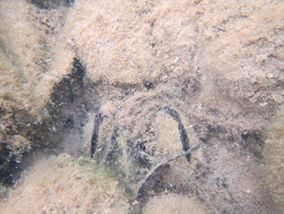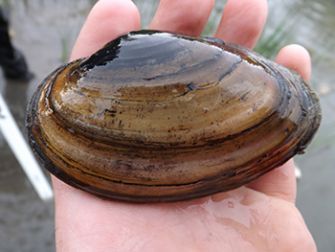Know Your Mussels: Native Mussels of Wyoming
Did you know...
that Wyoming’s streams and lakes are home to seven kinds of native mussels? You may not have noticed them, and they are not the kind you can eat, but they are working hard behind the scenes to keep Wyoming’s waters clean!
Mussel Facts

Mussels are animals with two shells and one foot, which live in the sediments of rivers and lakes. There are many amazing facts about mussels, but their life cycle is especially interesting. With only one foot, adult mussels can’t move far, so they rely on fish to transport their young. Some female mussels create a lure that looks like fish food (such as a crayfish or minnow) to attracts host fish. Once the fish bite the lure, the microscopic baby (larval) mussels are released from the parent mussel, and clamp onto the fish’s gills. This tactic gives mussels the ability to travel long distances by hitchhiking a ride on a fish, before letting go, settling to the stream or lake bottom, and growing into an adult.
Declines
North America has the greatest diversity of freshwater mussel species in the world (around 300), though about 32 species are thought to have disappeared from the United States. Globally, freshwater mussels are declining at an alarming rate and they are considered the most imperiled animals in North America. In Wyoming, no mussels are currently listed under the Endangered Species Act, but six mussels are listed as Endangered in adjacent states. Their decline is largely due to pollution, dams, and rearranging fish populations.
Need for Data
The information above sums up almost everything known about mussels in Wyoming. Besides the seven species that have been found living in the state, the shells of two other species have been found. For all nine of the species, very little is known about the distribution, and nothing is known about whether their populations are stable or declining. Without more information, it is impossible to make informed decisions about management strategies to protect these valuable animals. And our best source of information is people who spend time in or near streams and lakes—angler, boaters, naturalists, and other outdoor enthusiasts.
We need your help!

How to gather and submit observations
When you find one or more shells or live mussels at a site, take a photo, and record:
- Your location
- The species. If you can’t identify it, that’s OK; your photo will still be useful.
- The number of shells or living mussels
- Whether it’s a shell or live
- The length(s) of the shell
- Type of stream or lake sediments (pebbles, sand, mud, etc.)
When you get home, go to iNaturalist.org, and follow the instructions for uploading observations. (You will need to register the first time.) Information for 3, 4, 5 & 6 from the above list should be included in the comments area.
Thank you for your help!!
For more information, email biodiversity@uwyo.edu.
PROJECT NAVIGATION
MISSION
With your help, we can better understand where mussels live in Wyoming, what species are present, how abundant mussels are, and how they are doing. You can do this by submitting observations of any mussels (live and/or shells) you find in Wyoming to the iNaturalist website. We appreciate information on their location, identification (a simple key is available here), abundance (how many), shell length, and habitat where you found them. We encourage photos of the mussels and their habitat. For the best information on how to identify mussels, with lots of pictures and information about their life history, see the field guide Native Mussels of Wyoming, available through the Biodiversity Institute store.


